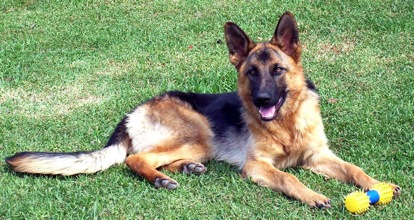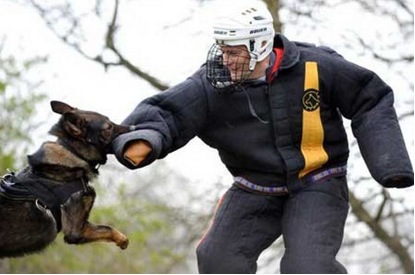Mike Talks shares with us the unlikely story of how his pet German Shepherd inadvertently became his team's QA manager. Talks explains how his German Shepherd was able to gather people together and have them talk to each other, similiar to what a QA manager does—keeping people on task, handing out assignments, and following up with team members.
Five months ago, my commute to work involved a daily train ride to Wellington, New Zealand. Once I arrived to my workplace, I would encounter the inevitable curveballs that my team’s waterfall project would throw us, always mindful of our target release date.
A lot has changed since then. We’re now agile and there are still curveballs, but instead of my team members feeling that those curveballs have the power to completely derail the project, they feel like they are only disruptions, at worse. And my commute? My journey to work now involves carpooling with Max, a new co-worker and manager, who has helped my members team more than we could have imagined.
Going agile wasn’t easy for us; anyone who says it is should probably take a lie detector test. One major impediment to our agile transition was due to physical space. Although we were all on one floor, we weren’t co-located. This led us to two key problems: a lack of team identity, and having no good place to hold meetings.
Let’s start with the meetings. To be frank, we were finding it difficult, with such a dispersed group, to collect everyone even for our standup meeting that we held at 10:30 each morning. For example, even though the meeting could be added to one’s calendar, some people were encouraged to turn off their email, which led to an inevitable result: they didn’t see the event notification. Additionally, we tried using a Harpo Marx horn, which I suggested, to call attention to the standup. Not only did this annoy the non-agilists on the floor, many team members wore noise-cancelling headphones, so wasn’t very effective.
Once we heard that there was a joke going around concerning us delivering software to our customers in a clown car, we ditched the horn almost immediately.
Hiring Max
Although thanks to Max, things have gotten better, I have to admit it’s not perfect. Sometimes, we hear from our developers statements like “Max is probably the best manager I’ve ever had.” There’s a lot of things you could say about Max that you’d hear about many managers, with the phrase “bark worse than his bite” being a common description. However, there’s some odd descriptions as well; when was the last time you worked for a manager who appreciated being tickled on his tummy? On second thought, maybe you shouldn’t answer that one.
This is probably a good time to include a picture of Max, which might explain a little.

Figure 1. My Co-Worker and Manager, Max
Max has a work history as impressive as any adult. He’s seven-years old and was destined at birth to become trained as a New Zealand police dog. Instead, he ended up working at New Zealand’s customs and immigration department, where he specialized in detecting contraband, especially narcotics.
Max came into our lives through my son'ss overwhelming desire to have a dog, and a German Shepherd no less. We found out about Max through a friend, employed by a local Alsatian rescue-and-housing section, who told us about a retired customs-and-immigration dog up for rehoming. While obtaining Max required commitment, including spending time with his handler to learn his commands and how to control him, it was worth it.
Like many great discoveries, it was an act of serendipity that Max found a role within my team. One day, my son went into town to visit a museum with Max. However, the museum did not allow for dogs to be admitted. So, dad came to the rescue, and Max ended up staying at my office.
If you’ve ever had a colleague on maternity leave drop by the office with a new baby, you’ve probably noticed how people seem to stop working and instead gather around the new-born to make “gaga” noises. This is nothing, believe me, compared to when one walks onto the office floor with a German Shepherd. Thankfully, in my case, once the commotion died down, we got back to business.
Max’s Skills Become Evident
My key meeting that afternoon should have been pairing up with my team’s chief developer Kevin, but he wasn’t at his desk and no one knew where he was. My mischievous side got the better of me, so remembering Max’s training lessons, I was able to get Max to sniff Kevin’s coat, after which I said “Go find.” Like something out of a Lassie move, Max sprang into action and followed the scent of the developer until I was led to the café on the ground floor. Sure enough, I found Kevin, who greeted us with an astonished “Oh, did we have a meeting?”
That afternoon, I found that our area recieved a lot more visitors than normal, with people dropping by to have conversations, although many of them were just excuses to come and pet the dog. I noticed that having a mascot like Max unified my team members like nothing I’ve tried so far. But, later that day, Max went home, and that (it seemed) was that. A few days later, however, one of our business analysts asked if the dog was going to come back to the office. I found myself wondering, “Well, why not?”
Originally, Max would come to our office for just an afternoon a week (if that), which was usually Friday. In true agile fashion, however, his role began to grow. As people introduced themselves to him, he got to know them by name. This was something that surprised me at first, but when I spoke to Max’s trainer, it seemed to echo how he was trained.
They say you can’t teach an old dog new tricks, but Max is living proof that you can take the skills you have and find a new context. When we’re missing souls at our standup, all you need to do is say “Get Jake,” and the game’s afoot to Max. This has increased the team members’ incentive to remember the standups; they do not want to be shamed by being dragged to the meeting by a fellow teammate. Shame is quite the operative word, as team members who happened to be in the bathroom before a standup were embarrassed to find an Alsatian barking outside their bathroom stall. Thankfully, people forgive Max in ways they’d never forgive any human manager.
Max wasn’t a true police dog, luckily, but a customs dog, so when he grabs you, he gets more of a hold on your clothing, rather than what the following picture shows.

Figure 2. "Mr. Developer, Your Presence Is Requested at the StandUp."
Regarding figure 2, we don’t disrespect our developers that much!
So Max became our “team herder,” and after all, isn’t that what the best managers do? With that he started to come into the office a lot more. Our standup meetings happened on time and with a better turnout. We also found that we had impromptu meetings much more. Although the novelty of Max did ebb off, people were naturally drawn to him. Thus, although Max never took part in the meetings, some of our most productive assemblies happened when we were around him.
My team members also shared a sense of responsibility for Max. Today, we have a roster of people who take him out for a brief walk around the nearby park in the morning and afternoon; usually, both parties seem better for it. And, twice a week there is a running group that takes Max out during lunchtime, which keeps him active.
He’s an excuse to socialise, and I’ve noticed moral is much improved. In fact, I’ve noticed the best way to find out if anything is wrong is to stick near Max. If people are having a bad day, they tend to seek Max out, and he can give non-verbal support like no other manager can.
Not only is he superb reviewer—Max tends to be used as a form of a rubber-duck reviewer—he is also ISTQB certified as a result of being snuck into an exam room by one of our testing pranksters. (I suspect someone took the test for him, to be honest.)

Figure 3. German Shepherds Are the Ultimate Rubber Duck Reviewers
When you think about what a QA manager does—keeping people on task, handing out assignments, and following up with team members—doesn’t a German Shepard fit that role pretty well by shepherding people into rooms and getting them to talk to each other?
Of course, this isn’t something that’ll work for just anyone. Most of all this calls for mature leadership, because believe me (as the developers have joked), you can come in every day and bring the team coffee and breakfast, but you’ll still never be as popular as your German Shepherd. What we've found through Max is that the secret to making your agile team work (especially when dispersed) is to find something, even if it's a rescue dog you sneak into the building, that your team can build an identity and gel around. What's your German Shepherd?


User Comments
High profile Max :)
Mike, great article and I really enjoyed learning about Max. You've giving me something to think about today regarding bringing a team together.
All the best,
Greg
Good comparision and well explained.
I love this story! There is research behind your observation that dogs in the workplace help us work more effectively. Many companies allow employees to bring dogs to work. Of course, if there are folks who are allergic or if the dog is not well-behaved, that's different, but otherwise, it's a wonderful idea. Now, to see some research on cats and birds and hamsters and...
Thanks for sharing!